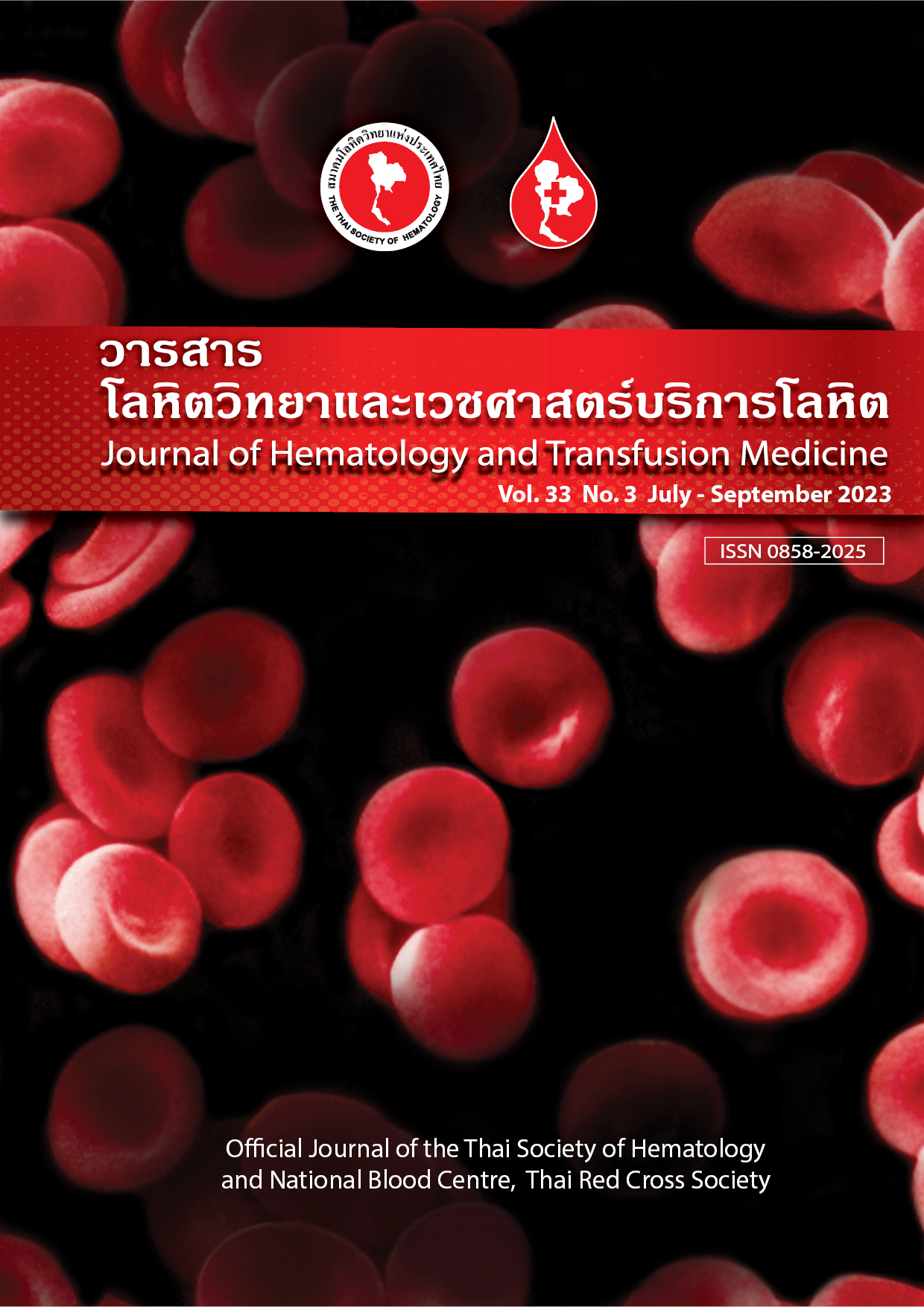Evaluation of HLA typing by next generation sequencing from proficiency testing data at Siriraj Hospital
Keywords:
HLA, Proficiency testing, เอชแอลเอ, การทดสอบความชำนาญ, Genes, Next generation sequencing, ยีน, การวิเคราะห์ลำดับเบสยุคใหม่Abstract
Abstract:
Introduction: HLA gene typing has been greatly improved by DNA sequencing using next generation sequencing (NGS), a high-resolution assay that is now being used in many laboratories. HLA gene testing plays an important role in hematopoietic stem cell transplantation and organ transplantation by selecting suitable donors for recipients. Objective: To evaluate the results of HLA typing by NGS method using data obtained from proficiency testing programs. Materials and Methods: The One Lambda, Inc., USA, AllType™ NGS assay kit and the Ion S5™ XL system instrument were used to examine 48 DNA samples from the Department of Transfusion Medicine, Faculty of Medicine Siriraj Hospital, Mahidol University in proficiency testing programs. Results: HLA-A, B, C, DRB1, DRB3/4/5, DQA1, DQB1, DPA1 and DPB1 typing results were concordant with the results of proficiency testing in HLA-A, B, C, DRB3/4/5, DQB1, DPA1, and DPB1 at 100% of all three institutions which the results were compared at high resolution at the HLA second field level. Only one sample was shown in the HLA first field level of HLA-DRB1, DQB1, and DPB1 typing. Conclusion: The HLA gene NGS assay using the AllType™ NGS assay and the Ion S5™ XL system yielded results concordant with proficiency testing results that can detect both HLA class I and class II genes.
บทคัดย่อ
คำนำ การตรวจ HLA ยีนมีการพัฒนาเทคโนโลยีอย่างมากในการหาลำดับเบสของดีเอ็นเอโดยใช้วิธี next generation sequencing (NGS) ซึ่งเป็นการตรวจที่มีความละเอียดสูงโดยกำลังจะถูกนำมาใช้ในหลายห้องปฏิบัติการที่มีการตรวจทางด้าน HLA ยีนโดยที่ HLA มีบทบาทสำคัญสำหรับการปลูกถ่ายเซลล์ต้นกำเนิดเม็ดโลหิตและปลูกถ่ายอวัยวะในการคัดเลือกผู้บริจาคให้เหมาะสมกับผู้รับ วัตถุประสงค์ เพื่อประเมินผลการตรวจ HLA typing ด้วยวิธี NGSโดยใช้ข้อมูลที่ได้จากการทดสอบความชํานาญ (proficiency testing) วัสดุและวิธีการ ใช้ชุดตรวจของ AllType™ NGS assay ของบริษัท One Lambda, Inc., USA โดยใช้เครื่อง Ion S5™XL system มาตรวจกับตัวอย่างดีเอ็นเอจากภาควิชาเวชศาสตร์การธนาคารเลือด คณะแพทยศาสตร์ศิริราชพยาบาลมหาวิทยาลัยมหิดล ที่เข้าร่วมการทดสอบความชํานาญ (proficiency testing) จำนวน 48 ราย ผลการศึกษา พบว่าผลตรวจ HLA-A, B, C, DRB1, DRB3/4/5, DQA1, DQB1, DPA1 และ DPB1 มีความสอดคล้องกับผลของ proficiency testing ใน HLA-A, B, C, DRB3/4/5, DQB1, DPA1 และ DPB1 ที่ 100% ของทั้งสามสถาบันโดยที่ผลการตรวจมีการเปรียบเทียบผลในระดับ high resolution ที่ HLA field ที่ 2 มีเพียง 1 ตัวอย่างที่ HLA-DRB1, DQB1, DPB1 ที่ผลออกมาใน HLA field ที่ 1 สรุป การตรวจ HLA ยีนโดยวิธี NGS ด้วยชุดตรวจของ AllType™ NGS assay โดยใช้เครื่อง Ion S5™XL system ให้ผลที่สอดคล้องกับผลการทดสอบความชํานาญโดยสามารถจะตรวจได้ทั้งในยีน HLA class I และ class II พร้อมกัน
Downloads
References
Barker DJ, Maccari G, Georgiou X, Cooper MA, Flicek P, Robinson J, et al. The IPD-IMGT/HLA Database. Nucleic Acids Res. 2023;51:D1053-D60.
Bentley G, Higuchi R, Hoglund B, Goodridge D, Sayer D, Trachtenberg EA, et al. High-resolution, high-throughput HLA genotyping by next-generation sequencing. Tissue Antigens. 2009;74:393-403.
Erlich H. HLA DNA typing: past, present, and future. Tissue Antigens. 2012;80:1-11.
Mahdi BM. A glow of HLA typing in organ transplantation. Clin Transl Med. 2013;2:6. doi: 10.1186/2001-1326-2-6.
Flomenberg N, Baxter-Lowe LA, Confer D, Fernandez-Vina M, Filipovich A, Horowitz M, et al. Impact of HLA class I and class II high-resolution matching on outcomes of unrelated donor bone marrow transplantation: HLA-C mismatching is associated with a strong adverse effect on transplantation outcome. Blood. 2004;104:1923-30.
Gandhi MJ, Ferriola D, Huang Y, Duke JL, Monos D. Targeted Next-generation sequencing for human leukocyte antigen typing in a clinical laboratory: metrics of relevance and considerations for its successful implementation. Arch Pathol Lab Med. 2017;141:806-12.
Bravo-Egana V, Sanders H, Chitnis N. New challenges, new opportunities: next generation sequencing and its place in the advancement of HLA typing. Hum Immunol. 2021;82:478-87.
Cargou M, Ralazamahaleo M, Blouin L, Top I, Elsermans V, Andreani M, et al. Evaluation of the AllType kit for HLA typing using the ion torrent S5 XL platform. HLA. 2020;95:30-9.
Danzer M, Niklas N, Stabentheiner S, Hofer K, Proll J, Stuckler C, et al. Rapid, scalable and highly automated HLA genotyping using next-generation sequencing: a transition from research to diagnostics. BMC Genomics. 2013;14:221. doi: 10.1186/1471-2164-14-221.
Geretz A, Ehrenberg PK, Bouckenooghe A, Fernandez Vina MA, Michael NL, Chansinghakule D, et al. Full-length next-generation sequencing of HLA class I and II genes in a cohort from Thailand. Hum Immunol. 2018;79:773-80.
Gonzalez-Galarza FF, McCabe A, Santos E, Jones J, Takeshita L, Ortega-Rivera ND, et al. Allele frequency net database (AFND) 2020 update: gold-standard data classification, open access genotype data and new query tools. Nucleic Acids Res. 2020;48:D783-D8.
Choe W, Chae JD, Yang JJ, Hwang SH, Choi SE, Oh HB. Identification of 8-digit HLA-A,-B,-C, and-DRB1 allele and haplotype frequencies in Koreans using the One Lambda AllType next-generation sequencing kit. Ann Lab Med. 2021;41:310-7.
Serov YA, Barkhatov IM, Klimov AS, Berkos AS. Current methods and opportunities of next-generation sequencing (NGS) for HLA typing. Cell Ther Transplant. 2016;5:63-70.
Hosomichi K, Shiina T, Tajima A, Inoue I. The impact of next-generation sequencing technologies on HLA research. J Hum Genet. 2015;60:665-73.
Fabreti‐Oliveira RA, Oliveira CK, Vale EM, Nascimento E. Next-generation sequencing of HLA: validation and identification of new polymorphisms in a Brazilian population. HLA. 2020;96:13-23.
Liu C, Duffy BF, Weimer ET, Montgomery MC, Jennemann JE, Hill R, et al. Performance of a multiplexed amplicon-based next-generation sequencing assay for HLA typing. PLoS One. 2020;15:e0232050. doi: 10.1371/journal.pone.0232050.
Smith AG, Pereira S, Jaramillo A, Stoll ST, Khan FM, Berka N, et al. Comparison of sequence-specific oligonucleotide probe vs next generation sequencing for HLA-A, B, C, DRB1, DRB3/B4/B5, DQA1, DQB1, DPA1, and DPB1 typing: toward single‐pass high‐resolution HLA typing in support of solid organ and hematopoietic cell transplant programs. HLA. 2019;94:296-306.
Boonpokkrong P, Khanuntong S, Tupmongkol T, Srisuddee A, Phiancharoen S, Nathalang O. Evaluation of test kits for HLA allele detections using next generation sequencing technique. J Hematol Transfus Med. 2018;28:249-57.
Shiina T, Suzuki S, Ozaki Y, Taira H, Kikkawa E, Shigenari A, et al. Super high resolution for single molecule-sequence-based typing of classical HLA loci at the 8‐digit level using next generation sequencers. Tissue antigens. 2012;80:305-16.
Hosomichi K, Jinam TA, Mitsunaga S, Nakaoka H, Inoue I. Phase‐defined complete sequencing of the HLA genes by next-generation sequencing. BMC genomics. 2013;14:355. doi: 10.1186/1471-2164-14-355.
Downloads
Published
Issue
Section
License
Copyright (c) 2023 Journal of Hematology and Transfusion Medicine

This work is licensed under a Creative Commons Attribution-NonCommercial-NoDerivatives 4.0 International License.



